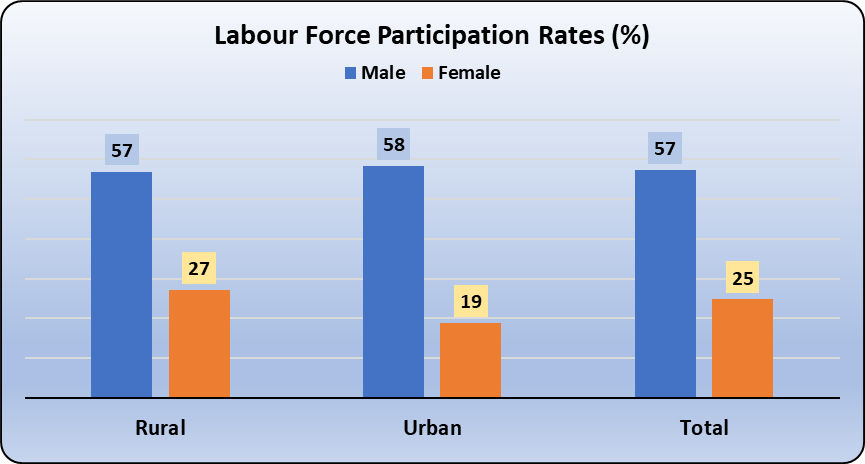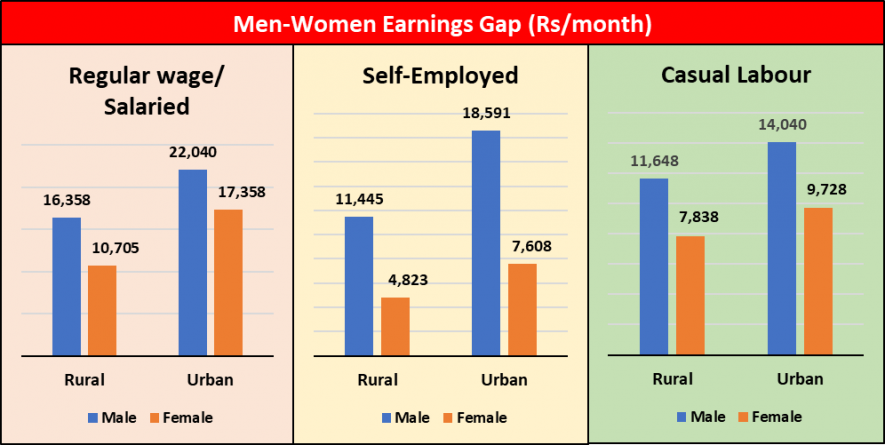Representational use only.Image Courtesy: Flickr
The share of women who are earning through work continues to remain shockingly low in India according to the latest data from the annual Periodic Labour Force Survey (PLFS) 2021-22 released last month. The report, compiled by the National Sample Survey Office (NSSO) under the ministry of statistics, also provides a glimpse of the unconscionable gap between the earnings of men and women.
Low Participation in Work
In rural areas, about 57% of men are in the labour force but only 27% of women. In urban areas, the situation is worse – men’s participation in the labour force is 58% while women’s is down to just 19%. Overall, this gives an average of 57% labour force participation for men and 25% for women. (See chart below) Labour force participation is the proportion of persons that are either employed or unemployed but seeking work.

Women’s labour force participation has broadly declined in the past three decades. Seen in the larger context of persistent unemployment and very minor growth of jobs generally, this speaks of a systemic obstacle to employment growth that successive governments and their economic policies have failed to address. With the new political attention on women as voters, it is strange that one of the key deprivations that women face – lack of job opportunities – remains a neglected policy area. But then, employment itself has become a neglected area, especially under the present government.
Agriculture is Mainstay for Women, and also Services
The PLFS 2021-22 report also gives an estimated distribution of men and women workers across different types of employment. In rural areas, obviously, agriculture is by far the main source of employment with 51% of men and a whopping 76% of women involved in it. For women, this is the biggest source of gainful employment dwarfing any other work. Among men, construction (17%), trade and hotels (11%), and manufacturing (8%) are some of the other sources of jobs in rural areas. But for women, apart from agriculture, only manufacturing (8%) and construction (6%) are of any significance.
In urban areas, since there is no significant farming work, women’s employment drops precipitously. Among those who do find work, the biggest chunk of nearly 41% is employed in various personal services, administration, education, healthcare, etc. These are women who are working as teachers, healthcare workers, domestic servants (maids, cooks, etc) and such other jobs. The manufacturing sector employs about 24% women in urban areas, mostly in certain industries like textile/garments. Trade and hotels/restaurants employ about 15% of the women and construction about 5%.
What these proportions show is that whether it is rural or urban areas, women are concentrated more in lower-paying, perhaps contractual-type jobs, often in the informal sector. It must be underlined that the PLFS numbers show up a remarkable fact: whether men or women, the manufacturing sector is employing not more than a quarter of the workforce. This indicates the paucity of the industrialised formal sector in the economy. On the other hand, agriculture still employs over half of men and three quarters of women in rural areas.
Wage/Earnings Gap
The other crucial information provided by PLFS 2021-22 is about the earnings of working people. Here the chasm between men and women is evident. This relegation of women to low-paying work or denial of equal pay for the same work is one of the factors that keeps women away from gainful employment – it is just not worthwhile for women to go out for work because of the miserable wages or earnings they get.
The chart below summarises wages earned by regular or salaried workers and casual workers, and also earnings of self-employed workers (like petty shop keepers, and sellers of labour like rickshaw pullers etc.). For regular workers, the gap between the wages of men and women is about 35% in rural areas and 21% in urban areas. For casual labourers, the chart shows daily wage rates projected to monthly rates for comparability, although in real life they get paid on daily basis with gaps in between. Here too the gap between men and women is large: about 33% in rural areas and 31% in urban areas. Mostly, their work would be the same, like carrying loads, digging etc.

In the self-employed category – which is the one with very large number of people working – the gap between men and women is very high. In rural areas, the difference between men’s and women’s earnings is as much as 58% while in urban areas it is 59%. In one month, a self-employed woman will earn only about Rs 5,000 in rural areas while her urban counterpart will get around Rs 7,600. This shows what the returns are for women running “enterprises” through Self-Help Groups (SHGs) and similar other programmes. Pakoda–making can hardly sustain women!
Apart from patriarchal obstacles put up by families and social peers, and issues of security, low wages such as these revealed by the PLFS are also contributing to the low labour force participation rates among women. This is despite the fact that women are much more educated today than three decades ago and want to become equal productive citizens.
Courtesy: Newsclick
